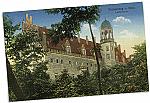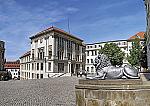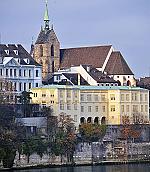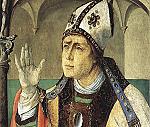Politics, popes, and Prague
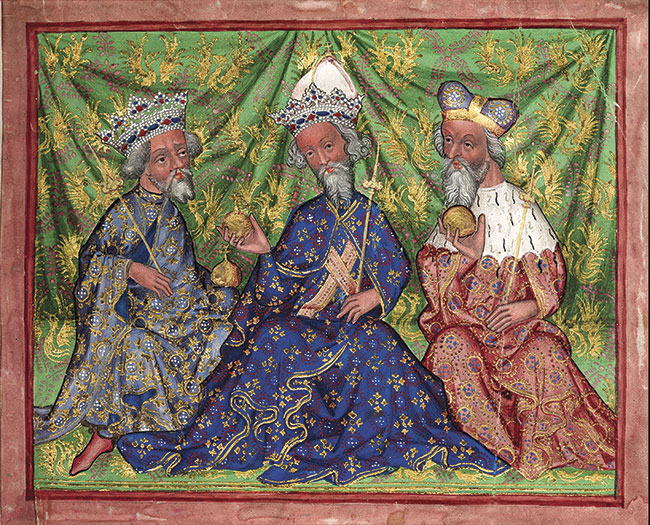
[ABOVE—Three rulers of the Luxembourg family: Bohemian kings Wenceslas IV, Emperor Charles IV, and Jobst of Moravia, Archive of the city of Olomouc, 95 fol. 1r—Used by permission of State District Archive Olomouc]
Ecclesiastes 4:12 tells us, “A cord of three strands is not easily broken.” This is a helpful analogy for the three main institutions of medieval Europe: church, empire, and university. These distinct, yet interconnected, authorities were collectively responsible for maintaining the common good. If one took a wrong turn, the others stepped in to right the course. But a sufficiently catastrophic failure in one could also cascade into the others. That is what happened at the University of Prague.
The other King Wenceslas
Dominating central Europe in the 1300s, the far-flung Holy Roman Empire was an unwieldy collection of territories ruled by an elected monarch claiming to succeed the ancient Roman emperors. When Charles IV of Luxembourg (1316–1378), a German, became king of Bohemia (1346) and Holy Roman Emperor (1355), his reign cemented a long, complex relationship between Germans and Bohemian Slavs. Four centuries before, Duke Václav the Good (c. 911–935), “Good King Wenceslas,” had been the first Bohemian ruler to cultivate a German alliance. Wenceslas rejected his grandfather’s Byzantine Christianity and his subjects’ paganism for Latin Christianity; he paid with his life.
Bohemian kings enjoyed special privileges among the empire’s prince-electors (powerful rulers who chose each Holy Roman Emperor). They had much power and few of the usual obligations of vassals toward their lords. Meanwhile many Germans had immigrated to Bohemia after Mongol displacements, where they had important roles in commerce and lived under their own law code. By this time Bohemians were unquestionably Catholic Christians. Still the anti-German sentiments that had led Good King Wenceslas’s subjects to kill him remained a sullen undercurrent.
In 1348 Charles IV established what was called the “Charles University” in Prague. Like many European universities, it was modeled on the University of Paris, organizing students and faculty into “nations” representing ethnic groups: Bohemian (Czechs), Bavarian (southern and western Germans), Saxon (northern and eastern Germans and Scandinavians), and Polish (northern and eastern Slavs). Each nation had its own rules, lived and ate together, and had one vote in debates over university policy.
Charles had his older son, Wenceslas IV (1361–1419), crowned king of Bohemia at age two and entrusted his education to the archbishop of Prague. Wenceslas grew up identifying with the Czech part of his father’s realm, while Charles’s younger son, Sigismund (1368–1437), eventually took control of Hungary through marriage. Charles managed to get 15-year-old Wenceslas elected as “king of the Romans” in 1376 but not crowned as emperor by the pope. To secure support for the election as king, Charles revoked several city-states’ charters and gave them to key nobles. This provoked a rebellion against Wenceslas, one of many that plagued his reign.
Enter the popes
All this took place against the backdrop of the medieval papacy’s failure to promote Christian flourishing. For much of the 1300s, popes had lived in the French city of Avignon, where French kings exercised significant—and resented—influence on the papacy. During the Avignon papacy, concerns about corruption in the church exploded. The English in particular resented being forced to contribute to support a papacy under the control of enemy French; Oxford theologian John Wycliffe (c. 1324–1384) rose to prominence during the 1370s for his attacks on the Avignon pope Gregory XI.
Wycliffe had developed a radically Augustinian theology in which the true church was the body of the elect. If a pope showed by his actions that he was not among the elect, then he could not effectively lead; he was in Wycliffe’s view, Antichrist. Wycliffe argued for a “poor church” under greater state control. He also attacked the doctrine of transubstantiation, a controversial position alienating some would-be supporters.
Meanwhile pugnacious itinerant scholar Jerome of Prague (1379–1416) had spent a decade migrating around Europe picking up degrees and starting fights with more traditional scholastic theologians. He encountered Wycliffe’s ideas at Oxford and brought them back to Prague, where they became immensely popular.
Jerome and his friend, the gentler, more moderate Jan Hus (c. 1372–1415), sympathized with Wycliffe’s key positions and their role in Christian formation: the church as the body of the elect, a godly clergy uncorrupted by power and wealth, and lay Christians’ reception of Christ in both bread and wine in the Eucharist.
Gregory XI finally returned to Rome in 1377, only to die the next year. The Roman mob pressured the cardinals to elect an Italian to keep the papacy in Rome, and they did: Urban VI. But Urban’s stern reforms made him unpopular, and the cardinals deposed him and elected another Avignon pope, Clement VII.
European monarchs lined up behind one claimant or the other. The French predictably supported Clement, and the English backed Urban. Now Wycliffe’s ideas became particularly appealing. What if the papacy had, in fact, become what Wycliffe warned against—Antichrist?
Without an undisputed pope, theologians suggested the Holy Roman Emperor could call a new council. But no emperor was in place—only the unfortunate, uncrowned Wenceslas. In 1398 the king of France persuaded Wenceslas to help ask both popes to resign. Boniface IX, Roman pope since 1389, belatedly offered to crown Wenceslas emperor. All this came to nothing.
After two years of inaction, powerful German electors had had enough. Led by Rupert of the Palatinate, they deposed Wenceslas and elected Rupert as “king of the Romans.” Rupert, with most of Germany behind him, solidly aligned himself with the Roman papacy. Wenceslas’s brother Sigismund invaded Bohemia in 1402. Scheming to become emperor himself, he imprisoned Wenceslas and coerced him into signing away his powers; Boniface supported this, making Wenceslas now ineligible to be crowned emperor.
Nation against nation
Wenceslas escaped, still claiming to be the rightful king. In 1408 he turned to the third strand of the cord: his father’s creation, the University of Prague. The University of Paris had supported a French king and rejected the Avignon pope when he would not step down. Wenceslas hoped Prague would play a similar role for him. But he ran into the “nation” system: the German and Polish nations remained loyal to Rupert and to the Roman pope.
Wenceslas now played his final desperate card; in the Decree of Kutná Hora in January 1409, he changed the university constitution to give his Bohemian allies the upper hand with three votes, while the other nations had one each. For the Germans this signaled heresy’s triumph at the university—through Wycliffe’s and Hus’s radical notions of Christian flourishing, as well as a corrupt king’s shameful attempt to manipulate academy and church into restoring his power. Johannes Hoffmann von Schweidnitz, rector of the university, led an exodus of about 80 percent of the faculty and students to Leipzig.
Hus became rector of what was left of the University of Prague. Over the next five years, his conflict with ecclesiastical authorities grew. When the Council of Pisa (1409) elected yet another pope (making three), Hus, Wenceslas, and the archbishop supported him. But the Pisan papacy lacked authority and proved to be even more corrupt than its two rivals.
In 1410 Rupert died. Sigismund secured his own election as “king of the Romans” and, unlike Wenceslas, took charge. In 1414 he called a new council at Con-stance, which, with his backing as the undisputed emperor-elect, succeeded in uniting Western Christian opinion. All three popes resigned or were deposed. The council elected a consensus pope, Martin V.
The Council of Constance summoned Hus to answer heresy charges. Sigismund issued him a safe-conduct but revoked it. Hus was burned at the stake in 1415, Jerome a year later. Hus’s followers in Bohemia took up arms against Sigismund, resulting in schism and the Hussite Wars. Within three years the once-flagship University of Prague was greatly diminished. Recalling the fallout from Sigismund’s treachery, Charles V chose to deal more faithfully with Luther a century later.
Meanwhile, the University of Leipzig grew and prospered. There, in 1519, John Eck forced Martin Luther to acknowledge his affinity with Hus’s condemned ideas, provoking Luther to a more decisive break with late medieval Catholicism. The road to the Reformation ran through the all-too-recent memory of the moment when the first German university was Czech. CH
By Edwin Woodruff Tait
[Christian History originally published this article in Christian History Issue #139 in 2021]
Edwin Woodruff Tait is contributing editor at Christian History.Next articles
The backwoods school that changed a continent
How Wittenberg helped spread Protestant reform
Beth KreitzerTolerant and pious
How Friedrichs University in Halle gave Europe a Pietist vision of the common good
Douglas H. ShantzChristian History Timeline: Godly learning, godly teaching
Christians through the centuries have wrestled with how to educate moral and virtuous people. Here are some milestones along the way.
the editorsSupport us
Christian History Institute (CHI) is a non-profit Pennsylvania corporation founded in 1982. Your donations support the continuation of this ministry
Donate



